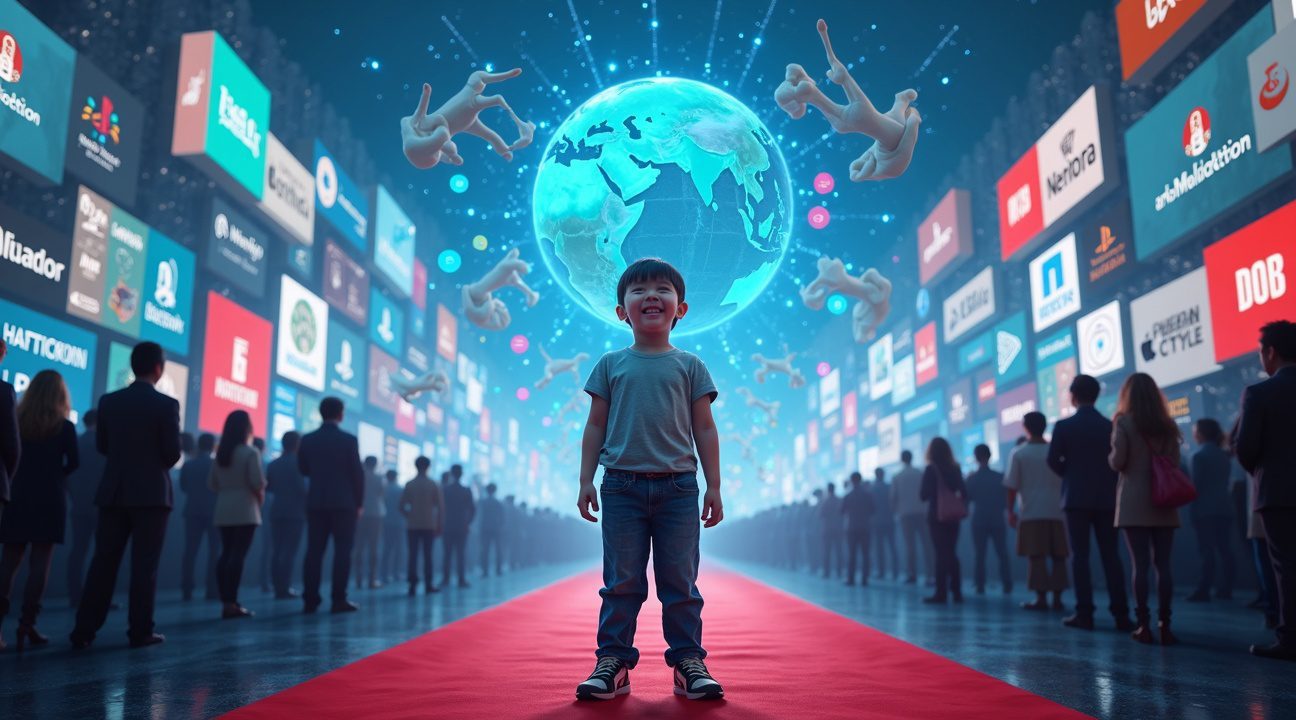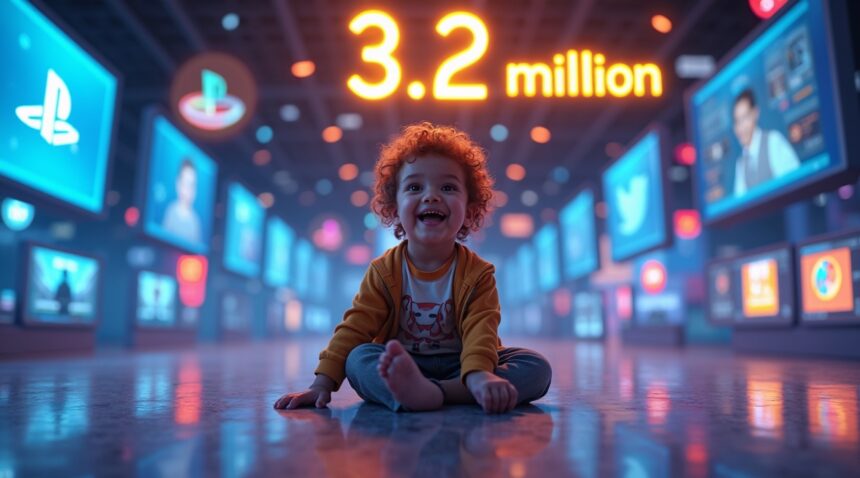A 4-year-old from Nashville, Tennessee has made history by becoming the world’s youngest millionaire after earning $3.2 million from a single AI-generated PlayStation advertisement that went viral across social media platforms.
Key Takeaways
- The Nashville toddler earned $3.2 million from one AI-generated PlayStation ad, far exceeding typical child actor earnings and establishing a new financial precedent for viral content.
- AI-generated advertising offers significant advantages including reduced production costs, faster content creation, and enhanced customization options that traditional marketing methods cannot match.
- The case raises important ethical questions about child participation in digital marketing, highlighting gaps in current legal frameworks created for traditional entertainment industries.
- Major corporations like Sony are recognizing AI-generated content as a legitimate marketing channel with substantial return on investment potential and viral reach capabilities.
- This success story signals a fundamental shift in child celebrity culture, where instant digital fame through AI-enhanced content can bypass traditional entertainment industry pathways entirely.
AI and the Future of Viral Marketing
AI-driven content creation has unlocked new possibilities for marketers, providing tools to generate personalized and engaging advertisements at scale. The viral success of the PlayStation ad starring the young Nashville millionaire proves how effective AI-generated visuals and narratives can be when combined with the massive reach of social media platforms. Companies looking to improve ad performance are increasingly turning to this innovative approach.
Legal and Ethical Challenges
This milestone also brings up challenges in areas such as digital rights, child labor laws, and content ownership. With minors now becoming digital influencers through AI-enhanced advertisements, there is a growing need to update regulations to protect their financial and emotional well-being. Examining models from traditional entertainment may prove inadequate in overseeing children’s roles in the digital space.
Corporate Interest in AI Marketing
Corporations like Sony are now prioritizing AI technologies as part of their marketing strategy. The cost-effectiveness and viral potential of AI-generated campaigns have shown impressive returns, encouraging further exploration and investment across industries.
The Rise of a New Generation of Digital Celebrities
This 4-year-old’s rapid success exemplifies how digital platforms are reshaping fame and fortune for the youngest generation. With AI tools readily accessible, children can now go viral and build audiences without the traditional support of television studios or talent agents.
Nashville Toddler Earns $3.2 Million from Single AI-Generated PlayStation Advertisement
A remarkable 4-year-old from Nashville, Tennessee has achieved something unprecedented in the digital marketing world. This young child became the world’s youngest millionaire after earning an astounding $3.2 million from a single AI-generated PlayStation advertisement that captured global attention.
The viral campaign showcased the toddler prominently in content created entirely through artificial intelligence technology. Unlike traditional commercial production methods, this approach eliminated the need for expensive filming equipment, large production crews, or lengthy shooting schedules. Instead, AI algorithms generated compelling visual content that resonated with audiences across multiple platforms.
This achievement far exceeds the typical earnings of established child actors and popular YouTube stars. Most young performers in traditional media earn thousands rather than millions for individual projects. Even successful child influencers with massive followings rarely generate this level of revenue from a single piece of content.
The Power of AI in Modern Marketing
The success of this Nashville toddler’s advertisement demonstrates several key advantages of AI-generated marketing content:
- Reduced production costs allow for higher profit margins for featured talent
- Faster content creation enables rapid response to trending topics
- Enhanced customization options create more engaging viewer experiences
- Broader distribution capabilities through AI-optimized platforms
The PlayStation advertisement’s viral nature stemmed from its unique blend of cutting-edge technology and authentic childhood appeal. Viewers connected with the genuine reactions and expressions captured through AI enhancement, creating an emotional response that traditional advertising often struggles to achieve. Sony’s recent focus on innovative marketing strategies has clearly paid dividends in this instance.
Marketing experts note that this case represents a shift in how brands approach youth demographics. Rather than relying solely on established celebrities or influencers, companies are discovering the untapped potential of authentic, AI-enhanced content featuring everyday children. The technology allows for professional-quality results while maintaining the spontaneous charm that makes young performers so appealing to audiences.
The $3.2 million earnings also highlight the financial opportunities emerging within AI-generated content creation. Parents and talent agents are beginning to recognize artificial intelligence as a legitimate pathway for young performers to enter the entertainment industry. This Nashville toddler’s success will likely inspire similar collaborations between AI technology companies and families seeking unique opportunities for their children.
PlayStation’s bold marketing initiatives continue to push boundaries in digital advertising, and this viral campaign exemplifies how innovative approaches can yield extraordinary results for all parties involved.

How AI Technology Created the Million-Dollar Advertisement
The viral PlayStation advertisement that catapulted a 4-year-old to millionaire status represents a significant breakthrough in artificial intelligence content creation. While specific details about the exact AI tools used in this campaign remain undisclosed, the technology behind such productions has become increasingly sophisticated and accessible.
Modern AI content generation platforms have revolutionized how advertisers approach campaign development. Tools like DALL-E excel at creating unique images from text descriptions, while Midjourney produces highly artistic visual content that captures attention instantly. For video production, Runway ML offers comprehensive video synthesis capabilities, and Synthesia specializes in creating realistic voice synthesis and virtual presenters.
The Technical Process Behind AI-Generated Campaigns
Creating an AI-generated advertisement typically involves several interconnected processes that work together seamlessly. The workflow often begins with concept development, where creators input detailed prompts describing the desired visual style, messaging, and target audience. Advanced algorithms then process these instructions to generate multiple variations of content elements.
Key advantages of AI-generated advertising include:
- Dramatically reduced production timelines from weeks to hours
- Lower operational costs compared to traditional film crews and studios
- Ability to generate multiple creative variations quickly for A/B testing
- Personalization capabilities that adapt content for different demographics
- Scalable content production for various platforms and formats
The success of this particular PlayStation campaign demonstrates how AI technology can level the playing field for content creators. Previously, producing high-quality advertisements required substantial budgets, professional equipment, and extensive technical expertise. Sony’s gaming division has likely taken notice of how AI democratizes content creation, potentially opening new opportunities for brand partnerships.
AI-generated content offers brands unique advantages in viral marketing potential. The technology can analyze trending topics, visual styles, and audience preferences to create content optimized for social media engagement. This data-driven approach increases the likelihood of content resonating with target audiences and achieving viral status.
Image synthesis technology has reached remarkable sophistication levels, producing visuals that often surpass traditional photography in creativity and impact. Video synthesis capabilities continue advancing rapidly, enabling creators to produce compelling motion graphics and animations without extensive technical backgrounds.
The integration of voice synthesis adds another dimension to AI-generated advertisements. Creators can now produce professional-quality voiceovers in multiple languages and styles, further expanding the reach and accessibility of their content. This technology proves particularly valuable for global campaigns targeting diverse markets.
Brand partnerships with AI-generated content creators represent an emerging trend that companies like PlayStation are exploring actively. These collaborations offer mutual benefits: brands gain access to innovative content while creators receive resources and platforms to showcase their work.
The viral nature of AI-generated content often stems from its ability to surprise and delight audiences with unexpected creativity. Machine learning algorithms can identify patterns and combinations that human creators might overlook, resulting in fresh perspectives and novel approaches to familiar products or concepts.
Cost efficiency remains a crucial factor driving adoption of AI content creation tools. Traditional advertising production involves significant expenses for location rentals, equipment, talent, and post-production services. AI-generated campaigns can achieve comparable or superior results at a fraction of these costs, making high-quality advertising accessible to creators with limited budgets.
The speed of AI content generation also enables rapid response to trending topics and current events. Creators can capitalize on viral moments and cultural phenomena by producing relevant content within hours rather than weeks, maximizing engagement potential and audience relevance.
Quality improvements in AI-generated content continue accelerating as algorithms become more sophisticated and training datasets expand. What began as obviously artificial content now often achieves photorealistic quality that rivals professional productions, opening new possibilities for creative expression and commercial applications.
Media Coverage and Public Response to the Viral Phenomenon
The remarkable story captured attention across both mainstream outlets and specialized gaming publications, creating a media frenzy that extended far beyond typical advertising news. Major networks picked up the story within hours of the advertisement’s initial surge, while tech blogs and AI-focused publications dove deeper into the technical aspects of the content creation process.
Public reaction split into distinct camps, with many expressing genuine amazement at how AI technology could enable such young creators to generate professional-quality content. The PlayStation gaming community particularly celebrated the innovative approach, seeing it as validation of AI tools’ democratizing potential in creative industries. Supporters argued that the child’s success represented a new era where age barriers in content creation were dissolving.
Social Media Engagement and Ethical Concerns
Social media platforms exploded with commentary, generating millions of impressions and shares across Twitter, TikTok, and Reddit. Gaming influencers and tech enthusiasts shared the content enthusiastically, while parenting groups raised pointed questions about exposing such young children to sudden wealth and public scrutiny. The discussion revealed deep divisions about child protection in digital spaces and the responsibilities of parents managing viral content.
Critics voiced concerns about exploitation, questioning whether a four-year-old could truly comprehend the implications of internet fame. Child development experts weighed in through various media appearances, discussing the psychological impacts of sudden celebrity status on developing minds. These conversations gained momentum when several advocacy groups called for stronger protections around children’s digital content monetization.
Digital Platform Amplification Patterns
The story’s spread followed predictable viral patterns, with initial gaming community engagement expanding into broader tech circles before reaching mainstream consciousness. PlayStation marketing campaigns historically generate significant buzz, but this story transcended typical product promotion boundaries. Content creators began producing reaction videos and analysis pieces, further amplifying reach across YouTube and streaming platforms.
News aggregators and entertainment sites picked up secondary angles, exploring everything from AI tool accessibility to the changing landscape of influencer marketing. International outlets covered the story through different cultural lenses, with some focusing on technological innovation while others emphasized child welfare concerns. This multi-faceted coverage ensured the story maintained momentum across diverse audience segments for weeks after the initial viral moment.
The phenomenon highlighted how quickly modern media cycles can transform personal stories into global conversations, particularly when they intersect with trending topics like AI advancement and Sony’s gaming initiatives. Commentary ranged from celebratory posts about democratized creativity to serious discussions about digital age parenting challenges.

Ethical Considerations and Industry Implications for Child Participation
This unprecedented case brings complex ethical questions about children in digital marketing to the forefront. When a four-year-old can generate millions through AI-driven content creation, I find myself questioning existing frameworks that govern child participation in commercial ventures.
Legal Frameworks and Child Protection
Current child labor laws weren’t designed for viral marketing phenomena. These regulations typically address traditional entertainment industries like television and film, where clear production schedules and defined working conditions exist. Digital platforms operate differently, creating content that can generate revenue indefinitely without ongoing child involvement.
The financial implications demand immediate attention from lawmakers. Unlike traditional child actors who earn money over extended periods, this child accumulated wealth through a single viral moment. I see this as a fundamental shift that existing Coogan Laws and similar protections don’t adequately address.
Parental involvement becomes particularly complex in these scenarios. Parents must balance their child’s immediate interests with long-term consequences while managing sudden wealth that exceeds most adult earnings. The responsibility extends beyond typical guardianship duties into territory that requires financial planning expertise and media management skills.
Industry Standards and Digital Ethics
The advertising industry faces pressure to establish clear guidelines for AI-generated content featuring minors. Current standards focus on traditional advertising methods, leaving significant gaps in digital marketing oversight. Companies like PlayStation and other major brands now must consider how their engagement with viral content impacts child participants.
Several key areas require immediate industry attention:
- Clear consent protocols for using children’s likenesses in AI-generated content
- Financial protection mechanisms similar to entertainment industry standards
- Guidelines for appropriate compensation levels for minor participants
- Requirements for ongoing child welfare monitoring during viral campaigns
- Protocols for managing sudden fame and its psychological impacts
The psychological implications concern child development experts significantly. Sudden wealth and fame can disrupt normal childhood development patterns. Unlike gradual fame through traditional entertainment paths, viral success creates instant pressure and attention that four-year-olds cannot comprehend or manage.
Social media platforms bear responsibility for protecting child participants in viral content. Current terms of service and community guidelines don’t specifically address situations where children become central figures in profitable marketing campaigns. I believe platforms need enhanced protections that automatically trigger when content featuring minors reaches certain engagement thresholds.
The financial aspect requires sophisticated trust arrangements and investment strategies typically reserved for much older individuals. Child financial protection laws vary significantly across jurisdictions, creating potential legal complications for international viral content. Parents must establish proper financial structures while ensuring compliance with multiple regulatory frameworks.
Marketing ethics committees within major corporations face unprecedented decisions about engaging with child-generated viral content. The potential for exploitation exists alongside genuine opportunities for positive outcomes. Companies must develop ethical frameworks that prioritize child welfare while acknowledging the commercial value of authentic, engaging content.
This case establishes precedent for future child participation in AI-driven marketing campaigns. The industry’s response will shape how similar situations unfold as AI content creation tools become more accessible. I anticipate regulatory bodies will need to develop specific guidelines addressing the intersection of artificial intelligence, child participation, and commercial advertising.
The rapid evolution of digital marketing tools means children can unknowingly create commercially valuable content through normal play activities. This blurs traditional boundaries between childhood expression and commercial participation, requiring nuanced approaches that protect children while allowing for authentic content creation.
Educational institutions and child advocacy groups now face the challenge of preparing families for potential viral success scenarios. The traditional advice about online safety and digital literacy must expand to include guidance about commercial opportunities and their implications for young children.

The Growing Influence of AI in Content Creation and Marketing
This groundbreaking case marks a significant shift in how advertising campaigns achieve viral status and generate substantial revenue. The four-year-old’s success with an AI-generated PlayStation advertisement demonstrates the transformative power of artificial intelligence in modern marketing strategies. Companies across various industries are taking notice of how generative AI tools can create content that resonates with audiences on an unprecedented scale.
Traditional advertising agencies often spend months developing campaigns with teams of creative professionals, copywriters, and designers. AI-driven content creation can produce comparable results in a fraction of the time while potentially achieving higher engagement rates. The viral nature of this particular advertisement suggests that AI-generated content might possess qualities that naturally appeal to digital audiences, particularly on social media platforms where authenticity and novelty drive sharing behavior.
AI’s Revolutionary Impact on Brand Partnership Strategies
Major corporations like Sony are beginning to recognize the potential of AI-generated content as a legitimate marketing channel. This case study reveals several key advantages that make AI content creation particularly attractive to brands:
- Rapid content production cycles that allow for quick market testing and iteration
- Cost-effective campaign development compared to traditional advertising agencies
- Ability to generate multiple content variations for A/B testing purposes
- Natural integration with social media algorithms that favor engaging, shareable content
- Potential for unexpected viral moments that traditional marketing might not anticipate
The return on investment potential for AI-generated advertisements appears substantial when considering the minimal production costs versus the massive reach achieved. While this particular case involved a gaming industry giant, similar opportunities exist across entertainment, technology, and consumer goods sectors.
Companies are now evaluating whether to develop internal AI content creation capabilities or establish partnerships with specialized AI technology firms. The success of this campaign suggests that brands willing to experiment with AI-generated content might discover new pathways to viral marketing success that bypass traditional advertising gatekeepers.
Digital marketing professionals are closely monitoring this development as it challenges established assumptions about what constitutes effective advertising content. The authentic, unpolished nature of AI-generated content often performs better than highly produced commercial advertisements, particularly among younger demographics who value genuine expression over corporate messaging.
The transformation extends beyond simple content creation into strategic campaign planning. AI tools can analyze trending topics, predict viral potential, and optimize content for specific platforms simultaneously. This capability allows brands to respond to cultural moments and trending conversations with unprecedented speed and relevance.
Advertising industry experts are debating whether this represents a fundamental shift or merely an interesting anomaly in marketing history. Early indicators suggest that AI-generated content will become increasingly sophisticated, making it harder to distinguish from human-created advertisements while maintaining the authentic appeal that drives viral success.
The collaboration potential between major brands and AI technology companies has expanded significantly following this case. Rather than viewing AI as a threat to creative industries, forward-thinking companies are exploring how to integrate these tools into their existing marketing workflows to enhance creativity rather than replace human insight.
Social media platforms are also adapting their algorithms to better support AI-generated content, recognizing that such material often generates higher engagement rates than traditional advertising content. This symbiotic relationship between AI content creation and platform algorithms creates new opportunities for brands to achieve organic reach without significant advertising spend.
The implications extend beyond immediate marketing success to long-term brand strategy considerations. Companies must now evaluate how AI-generated content aligns with their brand values and messaging while maintaining authenticity in an increasingly AI-driven content landscape. The youngest millionaire’s success story provides a compelling case study for brands considering this technological shift in their marketing approaches.

Impact on Future Child Celebrity Culture and Digital Fame
I observe a fundamental shift occurring in child celebrity culture as this unprecedented $3.2 million earning demonstrates the disruptive potential of AI-generated content. Traditional child stars typically accumulate wealth through years of television shows, movies, or music careers, yet this four-year-old achieved millionaire status through a single viral moment. This stark contrast highlights how digital platforms can compress the timeline for achieving extraordinary financial success.
Redefining Celebrity Pathways Through AI-Generated Content
The entertainment industry now faces questions about how to structure participation frameworks for children in AI-generated projects. Traditional child celebrity protections and earnings structures weren’t designed for instantaneous viral success or AI involvement. This case suggests that future digital fame might bypass conventional talent agencies, casting directors, and production timelines entirely.
Entertainment executives are likely reconsidering how they approach child participation in AI-generated advertising campaigns. The mobile gaming industry’s growth already demonstrates how quickly digital platforms can create new revenue streams, and this PlayStation ad success reinforces that pattern for child participants.
Financial Precedents and Industry Implications
I recognize several key factors that make this achievement particularly significant for establishing financial precedents:
- The speed of earnings accumulation compared to traditional child celebrity income streams
- The minimal time investment required versus years-long entertainment careers
- The global reach achieved through digital platforms rather than limited geographic markets
- The role of AI technology in amplifying a child’s natural appeal without extensive training or coaching
Questions about sustainability and replicability remain central to understanding this phenomenon’s broader implications. Not every child possesses the unique combination of natural charisma and circumstances that contributed to this particular success. The entertainment industry must consider whether attempting to replicate this model could lead to exploitation or unrealistic expectations for young participants.
Digital fame through AI involvement differs significantly from conventional child stardom paths. Traditional routes require extensive auditions, training, and gradual career building through multiple projects. This case demonstrates how a single AI-enhanced moment can catapult a child to international recognition and substantial wealth within days rather than years.
The advertising industry is particularly affected by these developments. Brands now recognize that incorporating children into AI-generated content can produce extraordinary engagement levels and viral potential. However, this recognition comes with increased responsibility for protecting young participants while harnessing their natural appeal ethically.
Future child celebrity culture may increasingly revolve around authentic moments captured and enhanced by AI technology rather than scripted performances or manufactured personas. This shift could democratize access to fame and fortune while simultaneously creating new challenges for protecting children’s interests and well-being.
The precedent established here suggests that entertainment and advertising industries must develop new frameworks for evaluating, compensating, and protecting child participants in AI-generated content. Traditional contracts, royalty structures, and protective measures may prove inadequate for addressing the unique circumstances surrounding viral AI-enhanced content featuring children.
I anticipate that this case will influence industry standards for years to come, potentially leading to specialized agencies, legal frameworks, and financial structures designed specifically for children participating in AI-generated content. The challenge lies in balancing the enormous opportunity these platforms present with appropriate safeguards for young participants who may not fully understand the implications of their sudden digital fame and financial success.

Sources:
Indifact – “The $3.2 Million Doodle: How a 4-Year-Old Nashville Toddler Became the World’s Youngest Millionaire with a Viral AI-Generated PlayStation Ad”


